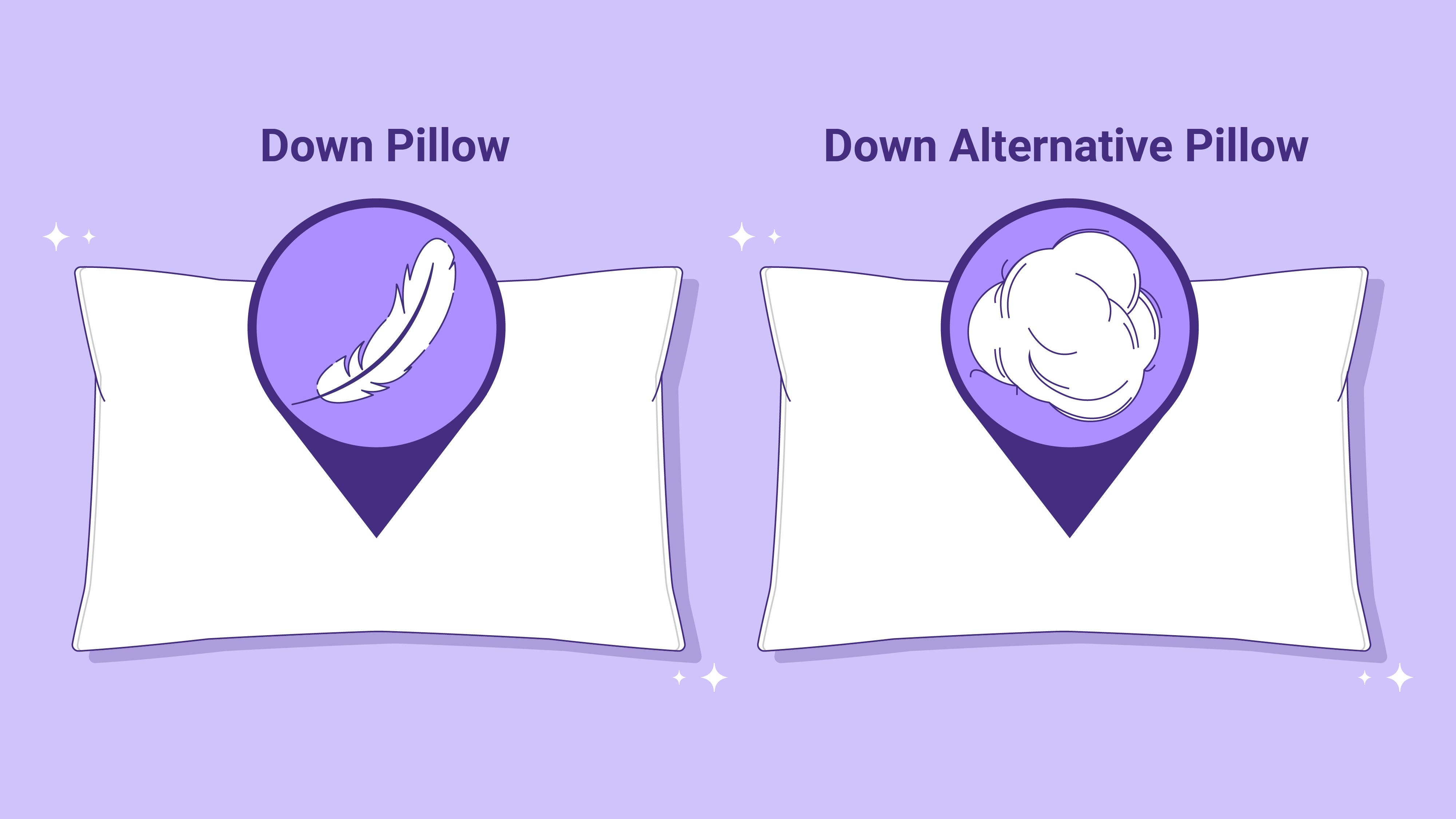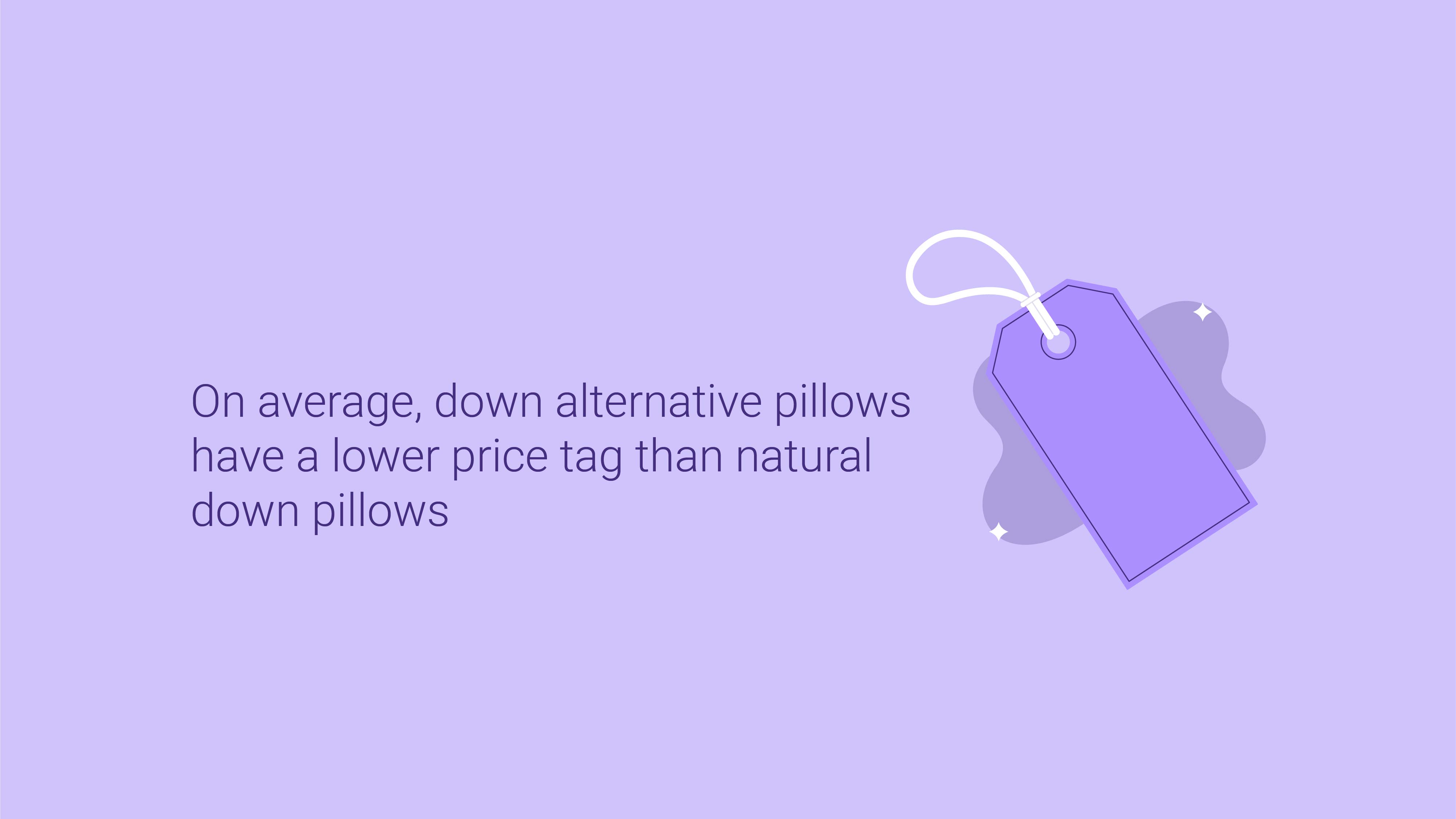
Down vs. Down Alternative Pillow: Which is Best?

- Natural down pillows offer a luxurious and plush experience, while down alternative pillows provide firmer support and easier maintenance, catering to different comfort preferences.
- Factors such as feel, temperature regulation, cost, durability, maintenance requirements, sustainability, and allergy relief should be considered when choosing between natural down and down alternative pillows, ensuring alignment with personal preferences and environmental considerations.
- Stomach and back sleepers may benefit more from the flexibility of down pillows, while side sleepers might find the firmer support of down alternative pillows more suitable for their needs, based on sleep position considerations.
There’s nothing more comforting than a squishy, cozy pillow. In fact, pillows are one of the most important elements of a good night’s sleep.
Pillows support your head, keeping your spine aligned and your neck straight. However, despite their importance, there are so many different pillow thicknesses, materials, and sizes, it can be tough to narrow them all down to one.
One of the most popular pillow materials is down. Down alternative has also arisen as another option besides animal-based natural down. These popular pillow fills both have their advantages and drawbacks. Let’s take a look.
Natural Down
Down is the layer of fine feathers underneath the exterior feathers of birds. The natural down filling comes from geese and sometimes ducks. This doesn’t mean down and feather pillows are the same thing, though. Down feathers don’t have a stiff shaft, so they won’t poke through your pillow.
Down is also a light and fluffy fill. So it makes for a high-loft, lightweight pillow that has a luxurious feel.
Down pillows are squishy and plush. They allow you to scrunch them and alter their shape to personalize your support (something firmer foam and cotton pillows don’t do as well). On the other hand, down pillows tend to collapse more than others. So if you need firmer support, down may not be for you.
Down Alternative
Down alternative, as its name suggests, is not down but is made to feel like down. This filling is polyester, a petroleum-based fiber. This means a down alternative is entirely synthetic. However, a down alternative is still supple and flexible. It is possible to customize the pillow’s shape by moving the fill clusters around. Still, a down alternative fill is not as squishy and scrunchable as down.
Down alternative pillows offers firmer support and more substance than down. While down feels like sleeping on cotton candy, down alternative feels more like sleeping on cotton balls. Sleepers who need more support might prefer a stiffer down alternative to squishier down, while sleepers who want more customization may want actual down.
Down vs. Down Alternative: Advantages and Drawbacks
Down and down alternative are very different fills, despite their names. There are some contests where down is the clear winner and others where down alternative takes the prize. Let’s take a look at how they stack up to make it easier to choose the best pillow.

Feel
This contest is based more on your personal preferences and sleep needs rather than objective facts. If you want a squishier, fluffier pillow with tons of loft and not a lot of weight, go for down. If you want a more substantial pillow with firmer support, you will probably be better off with a down alternative pillow.
Temperature
One of down’s jobs in nature is to keep birds warm and dry. That means down has more of a tendency to retain heat. For this reason, down is used as a fill in high-quality winter gear like coats and ski clothing. Down also is a popular fill for winter-weather duvets and comforters. If you sleep cold, you might enjoy down’s cozy feel, especially since down is surprisingly breathable despite its warmth.
Down alternative is a breathable alternative to natural down, making it an excellent cooling pillow. Down alternative tends to disperse heat better than down, meaning if you sleep hot, down alternative is likely a better option for you.
Keep in mind that both down and down alternative fills are more breathable and cooler than the average memory foam pillow. For an in-depth comparison, see our memory foam vs down pillow guide.
Cost
Down alternative is the clear winner when it comes to initial cost. On average, down alternative pillows have a lower price tag than natural down pillows. However, this category is more complicated because natural down is more durable than down alternative.
That means when it comes to how often you need to replace a pillow, you will be replacing down alternative pillows more frequently than down pillows. This might or might not wind up costing you more in the long run, depending on how much you paid for your pillows and how long they last.
Durability
As we said above, natural down is the winner in this category. Down pillows, and even regular feather pillows, tend to maintain their loft and support longer than down alternative pillows. Down can last up to a decade with proper care. Down alternative loses its loft and fluffiness in as little as a year or two.
Maintenance
A down alternative fill is easier to maintain than down. Down is more prone to clumping than down alternative. Many down pillows state they’re dry-clean-only. Washable down pillows still need to be soak-washed in a machine without an agitator or in a bathtub with a powder detergent to prevent clumping. Down pillows also can’t be heat-dried.
Meanwhile, you can just toss most down alternative pillows in the washing machine with your regular detergent and dry them on low without worrying about it. For more information, see our guide on washing pillows.
Sustainability
Eco-friendliness is a complicated category when it comes to down and down alternatives. On the one hand, buying durable down pillows that last a long time means you won’t be throwing pillows in the garbage year after year. Plus, down also creates much less chemical waste than polyester manufacturing, and it’s biodegradable to boot.
On the other hand, breeding and raising animals leaves its own carbon footprint. Ducks and geese require land and feed, and they produce waste. The cruelty of down is also an issue. Live plucking causes the birds a lot of distress. But cruelty-free down is hard to find and expensive. And if you’re only interested in pillows free of animal products, natural down is not an option.
Allergy Relief
Despite what a lot of people think, down can sometimes be hypoallergenic. Many people believe they’re allergic to down because it’s an animal product. However, most people are allergic to the dust, pollen, and dust mites in their pillows. Some people have an actual down allergy, but most don’t. That means keeping your down pillows clean is probably the solution to your allergies rather than getting rid of them in favor of alternative down.
However, for those who have sensitivities to bird feathers, down alternative is a much more hypoallergenic solution. Since it’s polyester fiber, it’s a safer bet for anyone concerned about allergens. But the best thing you can do to reduce your allergy symptoms is to keep your pillows clean, no matter what the fill is.
Sleepers who are sensitive to animal products have more than just a down alternative pillow to consider, of course. Memory foam pillows are an excellent choice when it comes to pillows with comfy, synthetic materials. See our memory foam vs down pillow guide for more information.
FAQs
What’s the difference between down and feather pillows?
While both down and feather pillows contain feathers, the type of feather does make a difference. One of the biggest issues with feather pillows is the quill. Feather pillows use feathers with shafts or quills. The hard, needle-like shaft can poke through the casing of your pillow and stick you. Shafts bursting through the cover won’t happen with down.
Feather pillows also don’t maintain their loft as well as down pillows. For example, many couch cushions have feather fills, and you may notice you have to fluff them up all the time. Again, this will be true of feather bed pillows, but down will resist going flat better than feathers.
Which sleep positions are down pillows best for?
Your sleep style has a lot of impact on your fill needs. Down is squishy and flexible, meaning it’s a great fill for stomach and back sleepers. Stomach sleepers need a flatter pillow, so a soft, low-loft down pillow that squishes almost to the bed is likely their best option.
Back sleepers need a pillow that can conform to their shape, collapsing under their heads and filling the gap under their necks. Down is more flexible than down alternative, meaning it will probably be better for back sleepers.
Which sleep positions are down alternative pillows best for?
Down alternative pillows are less squishy and fluffy than down pillows. That makes them good for side sleepers. However, side sleepers need the most loft and support, so they may find even the loftiest goose-down pillows too squishy for all-night use. The firmer support offered by down alternative pillows may be a better option for side sleepers.
Can a down alternative pillow fight mold and mildew?
Polyester and other synthetic materials make a hostile environment for microbial growth. Down alternative is also breathable, the fill wicking away moisture. That means it can stay dry even if you sweat while you sleep. All this makes down alternative resistant to mold and mildew growth.
What’s the best down alternative?
While a down alternative fill is traditionally made of polyester microfibers, it can also be made of cotton or other plant-based materials. Polyester down alternative feels more like down because it’s designed to mimic down clusters. However, if you don’t want a synthetic fill, cotton or kapok pillows are a good option.
Cotton is low-maintenance, breathable, and firm. It is perfect for side sleepers or hot sleepers. Kapok fiber is made of the silky thread that lines the seed pods of the kapok tree. Kapok is soft, fluffy, and all-natural. The material is great for people seeking a plant-based fill that feels a bit similar to natural down.
Bottom Line
Depending on your personal preferences, both down and down alternatives can offer a great night’s sleep. Down products are warmer, squishier, and fluffier. But down alternative products are cooler, weightier, and more supportive. Keep these attributes in mind, as well as your sleep style and needs, while you shop.
